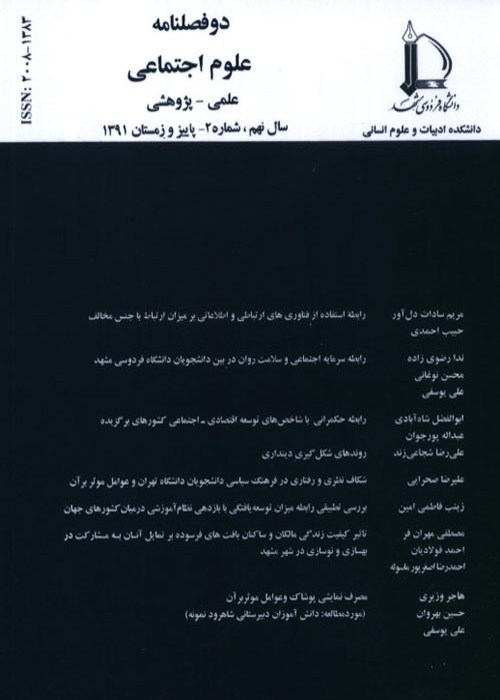Studying the Social Contexts of HIV Infection Using Grounded Theory Strategy
Author(s):
Article Type:
Research/Original Article (دارای رتبه معتبر)
Abstract:
1. Introduction
Today, the status of HIV/AIDS in Iran has transitioned from being covert to a centralized epidemic. It appears that the growth in HIV epidemic has been influenced by social changes that have occurred in Iran during recent years. As a social construct, or more particularly, a social stigma, HIV targets the individuals’ social status to various extents. Accordingly, a the question that arises is that considering the acute physical, spiritual, and social issues created by HIV in Iran, how, under what circumstances, and with what extent of knowledge do people engage in risky behaviors that potentially result in HIV transmission? The present study seeks to provide answers to these questions by studying the lived experiences of infected patients.
2. Theoretical Framework
In this study, the anomie theory put forth by Durkheim, Sutherland’s differential association, and Collins’ gender stratification were used as the theoretical frameworks. Risky behaviors were considered a result of the fading authority of sexual norms, learned behaviors, and gender discrimination according to theories put forth by Durkheim, Sutherland and Collins, respectively.
3. Method
Given the purpose of the study, i.e. extracting a theory with regards to social contexts of HIV infection, the grounded theory was used. In this approach, theories and data are directly extracted from the set of arranged collected data. According to Glaser, data should be used in theory, meaning that researchers should personally be involved in the data collection process. Similar to other qualitative approaches, data for grounded theory can be collected from a variety of sources. Data collection process entails interviews as well as observations. Data are collected until theoretical saturation is achieved. The foundation of analysis procedure is based on coding; in grounded theory, there are three basic types of coding including open, axial, and selective. Open coding is an interpretive process through which data are analytically broken into smaller units. The purpose of this is to provide new insights for the researcher by breaking data into smaller units and interpreting phenomena reflected from data. Selective coding is a procedure in which the entire classifications are unified around a “core category” while categories that require more explanations are placed under the title “further explanation”. This type of coding can be carried out at later stages (Corbin & Strauss, 1990). At the first stage, given the exclusivity, sensitivity, and difficulty of access to participants, purposive sampling was employed. Then, theoretical sampling was used in order to create the theory. Theoretical saturation was achieved at interview number 17, though the coding process was continued until interview number 19 so as to make sure there are no other new categories. In this study, 9 women and 10 men admitted to the behavioral healthcare center in Mashhad were examined. Information and data were collected through conducting open and in-depth interviews.
4. Results and Discussion
Following the analysis of the findings, as set of categories were identified which included Abnormal character development during adolescence as the contextual condition, familial disorganization as the causal condition, low health literacy level as the meddling condition, deterministic interactions encouraging individuals to engage in behaviors which might cause infection, lifestyle prone to infection, and environmental conditions and interactions prone to unconventional behaviors during adulthood as interactions, and passive infection, infection with low degree of freedom, and active infection as consequences.
5. Conclusion
According to the description of causal, procedural, and consequential categories, HIV as a disease caused by familial disorganization coupled with health-related negligence as the core category covers the entire mentioned topics. Ultimately, considering the individual’s degree of freedom in engaging in risky behaviors, the behaviors leading to HIV infection follows three basic patterns including passive infection, infection with low degree of freedom, and active infection, each under the influence of various interactions.Passive infection in which the individual is of minimum authority in the occurrence of a risky behavior originates from severe poverty and traumatic life experiences which significantly restrain the individual’s power of decision-making with respect to controlling their risky behaviors, rendering them prone to infection. Active infection is, to a high extent, influenced by environmental conditions and the individual’s delinquent interactions during adolescence; to satisfy their sense of pleasure, the individual becomes involved in risky behaviors with high potentials of infection such as having numerous sexual relations and drug abuse. Infection with low degree of freedom is caused by interactions which can be regarded as a lifestyle prone to infection. An individual suffering from addiction or one under the influence of undesirable living conditions who has chosen a spouse with a drug injection background has a moderate authority in controlling their behaviors in line with HIV prevention.Keywords:
Language:
Persian
Published:
Journal of Social Sciences, Volume:15 Issue: 2, 2019
Pages:
105 to 132
magiran.com/p2019729
دانلود و مطالعه متن این مقاله با یکی از روشهای زیر امکان پذیر است:
اشتراک شخصی
با عضویت و پرداخت آنلاین حق اشتراک یکساله به مبلغ 1,390,000ريال میتوانید 70 عنوان مطلب دانلود کنید!
اشتراک سازمانی
به کتابخانه دانشگاه یا محل کار خود پیشنهاد کنید تا اشتراک سازمانی این پایگاه را برای دسترسی نامحدود همه کاربران به متن مطالب تهیه نمایند!
توجه!
- حق عضویت دریافتی صرف حمایت از نشریات عضو و نگهداری، تکمیل و توسعه مگیران میشود.
- پرداخت حق اشتراک و دانلود مقالات اجازه بازنشر آن در سایر رسانههای چاپی و دیجیتال را به کاربر نمیدهد.
In order to view content subscription is required
Personal subscription
Subscribe magiran.com for 70 € euros via PayPal and download 70 articles during a year.
Organization subscription
Please contact us to subscribe your university or library for unlimited access!


